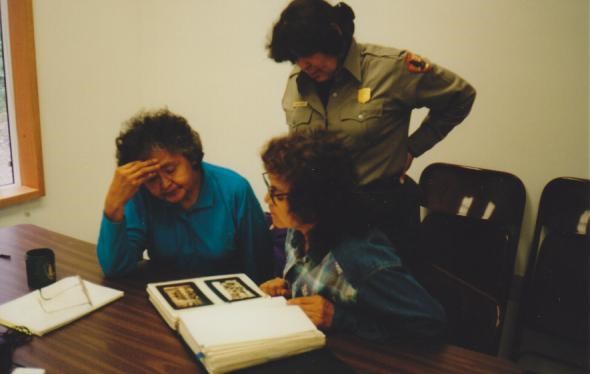Last updated: October 25, 2023
Article
Case Study: Online Exhibits
Online exhibits are one way that some National Park Service units have shared oral history interviews with a wide audience. Partnerships with universities often provide the digital storage space necessary for such ambitious projects.
Project Jukebox
NPS units in Alaska have collaborated with the University of Alaska Fairbanks Oral History Project Jukebox to produce numerous multi-media online exhibits. Developed in 1988, Project Jukebox pioneered digital recording and creating online exhibits that combine oral history audio with related transcripts, photographs, maps, and text.

Photo by Bill Schneider / Lena Farkas Slideshow in Oral History Project Jukebox (Wrangell-St. Elias National Park Project)
Denali National Park & Preserve collaborated with Project Jukebox to produce and share its collection of interviews about mountaineering. On Denali Mountaineering climbers describe the challenges, dangers, and rewards of climbing on Denali. Topics they discuss include climbs and routes; accidents and rescues; climbing philosophy, technology, and management; mountaineering transportation and access; mountain physiology; mountain science; guiding; and freighting. NPS personnel are among the climbers interviewed.
The Wrangell-St. Elias National Park & Preserve Project Jukebox features oral history interviews and photographs from Native and non-Native people who lived near or have been associated with the park, located in south-central Alaska. Narrators describe subsistence living, trading and trapping, copper mining, and the establishment of the park itself.
Sitka National Historical Park Project Jukebox uses oral history and photographs to chronicle the park’s history, its facilities, and its importance to members of the Sitka community. Narrators include Tlingit elders and NPS personnel.
Additional NPS Oral History Online Exhibits
Rosie the Riveter/World War II Home Front National Historical Park, in collaboration with the Regional Oral History Office at the University of California at Berkeley, has conducted interviews with residents of the San Francisco Bay Area about their experiences during World War II. The Berkeley Library hosts interview transcripts and recordings on its website. Men and women from diverse backgrounds share why they migrated to the Bay area, what they did when they arrived, and how the flux of wartime life shaped decisions they made at war’s end.
At Manzanar National Historic Site, oral history interviews have been crucial to interpretation, education, and resource management. Its oral history project documents the World War II history of Japanese Americans at Manzanar and elsewhere through the personal accounts of the formerly incarcerated, government staff, military personnel, and residents of communities near the camps. Some of the site's oral histories are available online through the Densho archive, California Light and Sound and on Manzanar's YouTube Channel.
The Fort Hunt Oral History Project, completed by rangers at the George Washington Memorial Parkway, features the memories of those who during World War II participated in highly classified intelligence programs at a secret military installation at Fort Hunt. It’s code name was PO Box 1142. The oral histories represent the first time that veterans of the project discussed their clandestine intelligence gathering that included interrogating high-level prisoners German generals, nuclear scientists, and heads of spy organizations.
Interviews with missileers, security and maintenance team members, peace activists, and local citizens offer multiple perspectives on Minuteman Missile National Historic Site's Cold War history series.
The Harry S Truman National Historic Site shares oral history interviews conducted with family, friends, neighbors, and White House staff knowledgeable about the Missouri home of the thirty-third U.S. president. Interviews have provided insights that were crucial to interpret, furnish, and preserve the home in a way that reflected the Truman family’s activities there.
Explore Online Exhibits
-
 AlaskaProject Jukebox
AlaskaProject JukeboxNPS units in Alaska collaborated with the University of Alaska Fairbanks on audio recordings, transcripts, photographs, maps, and text.
-
 Rosie the Riveter NHPWorld War II Home Front Oral Histories
Rosie the Riveter NHPWorld War II Home Front Oral HistoriesThe park and University of California at Berkeley conducted interviews with Bay Area residents about their experiences.
-
 Manzanar National Historic SiteManzanar Oral Histories
Manzanar National Historic SiteManzanar Oral HistoriesOral history projects document the World War II history of Japanese Americans at Manzanar are used in interpretation and education.
-
 George Washington Memorial ParkwayFort Hunt Oral History Project
George Washington Memorial ParkwayFort Hunt Oral History ProjectInterview audio and transcripts share accounts of the highly classified intelligence programs during World War II, code name PO Box 1142.
-
 Minuteman Missile National HistoricCold War Oral History Series
Minuteman Missile National HistoricCold War Oral History SeriesInterviews with Air Force personnel and citizens associated with the site history.
-
 Harry S Truman NHSOral History Project
Harry S Truman NHSOral History ProjectInterviews with family, friends, neighbors, and White House staff provide insights into understanding and interpreting the home.
